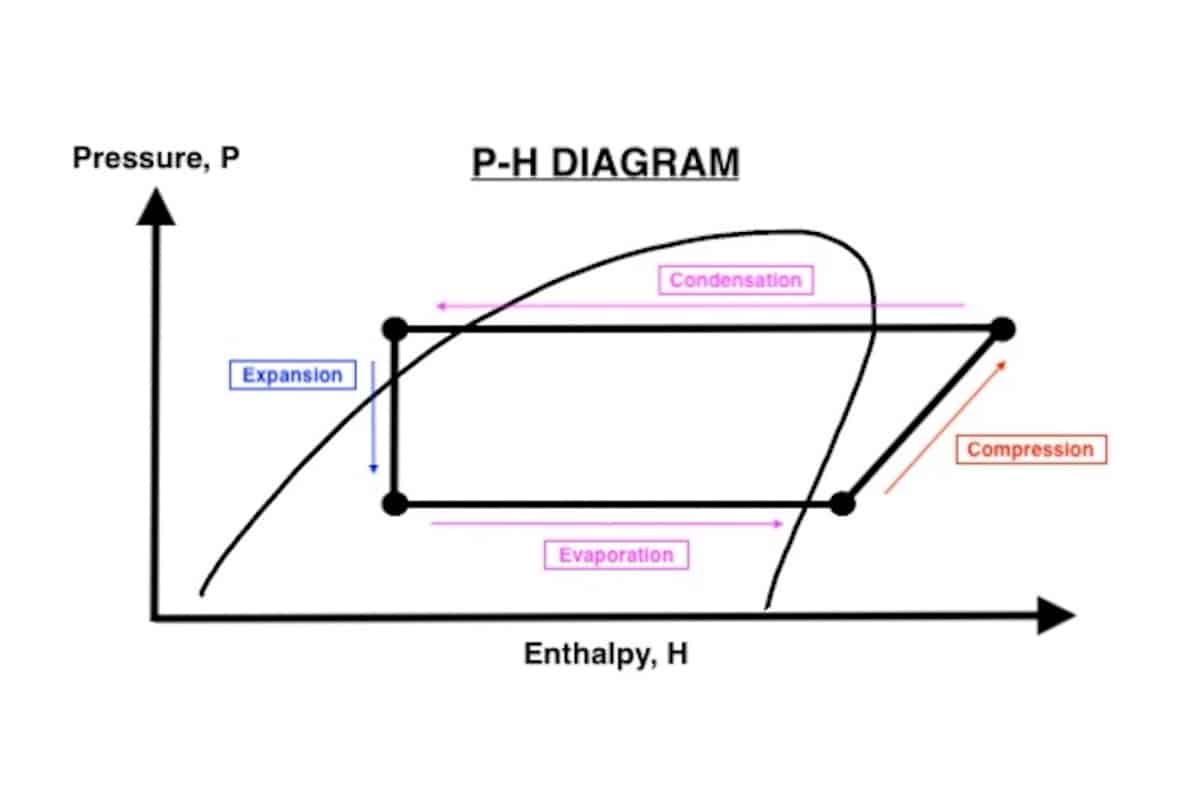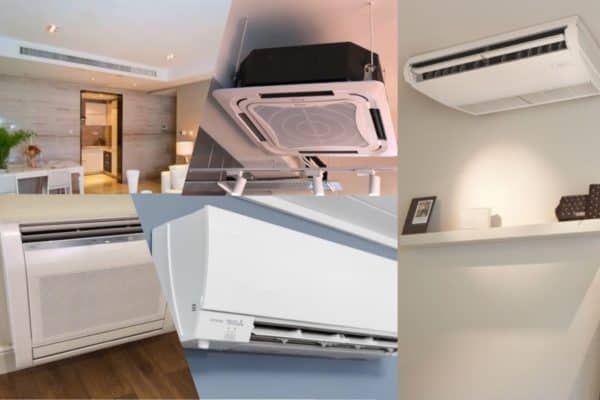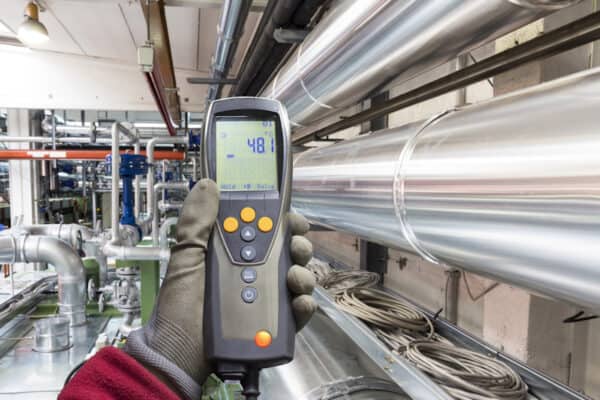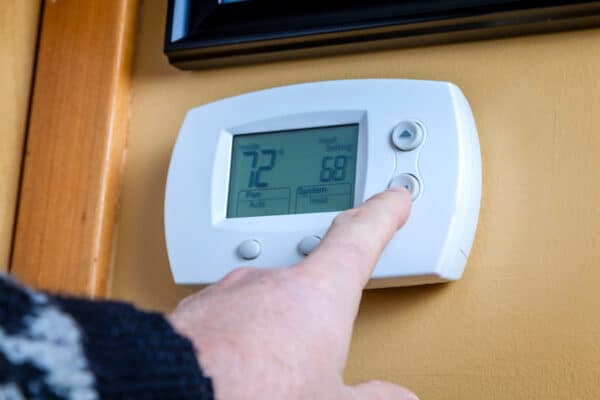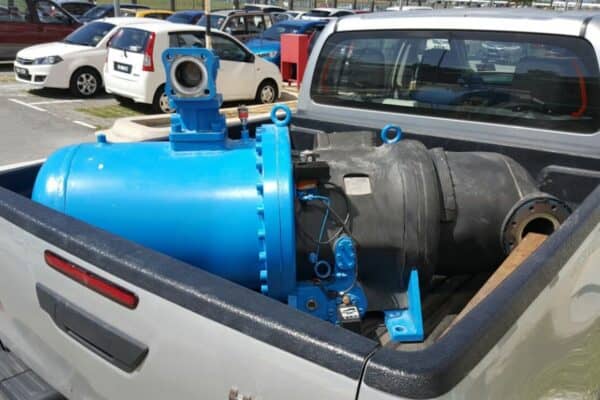Air Conditioner Working Principle Simple Explanation with Diagram
After spending countless hours studying how an air conditioner works, I put together all my research and explaining them in layman’s terms here.
To produce this article, I read books and journals to boil things down and organize the technical terms into simple language for easy understanding.
In this article, I’ll be covering more than just the refrigeration cycle. I’ll be explaining the relevant processes and components to give you the whole picture of how an air conditioner works. This will be quite long so let’s get started.
If you prefer video, I have one on YouTube which go in-depth into the fundamental of how air conditioners work. Below is the video about how air conditioners work:
Basic Working Principle of An Air Conditioner
The principle of air conditioning is based on the laws of thermodynamics. An air conditioner operates using the refrigeration cycle. Specific refrigerants are needed as the working fluid in the refrigeration cycle.
An air conditioner goes through 4 processes; compression, condensation, expansion, and evaporation. Typically, an air conditioner is made up of 4 major components; compressor, heat exchanger, fan, and expansion valve.
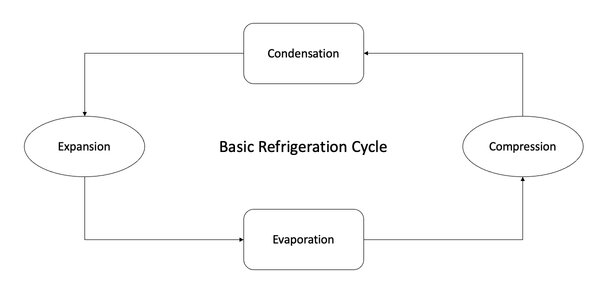
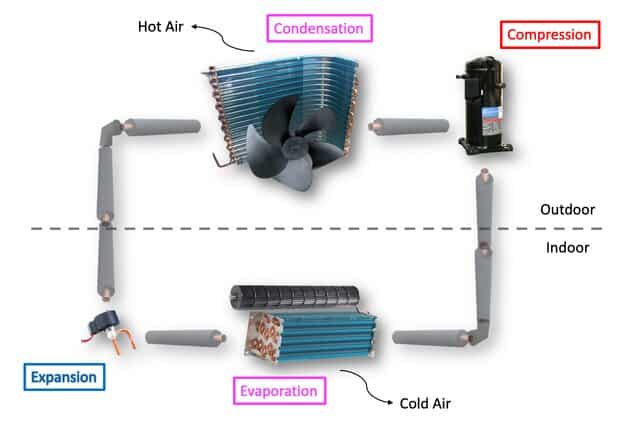
Besides, air conditioners have other components such as filter drier and printed circuit board, these components will be covered later in this article.
In an air conditioning system, pipes are needed to transfer heat energy from indoor to outdoor. Insulation is always required in an air conditioning system to prevent energy loss.
An air conditioner not just cools or reduces the temperature of the air, it also dehumidifies the air to a level that is comfortable to humans.
An air conditioner also provides a certain degree of air filtration during the cooling process.
Refrigerant for Air Conditioning
Refrigerant is the working fluid in an air conditioning system. Refrigerant is a general name given to a group of chemicals such as hydrofluorocarbons (HFCs), ammonia, propane, and carbon dioxide.
The fluid used in the refrigeration cycle is called a refrigerant, makes sense. A refrigerant doesn’t necessarily have to be a chemical that we rarely heard, even air and water can be called a refrigerant as long as they are the working fluid in the refrigeration cycle.
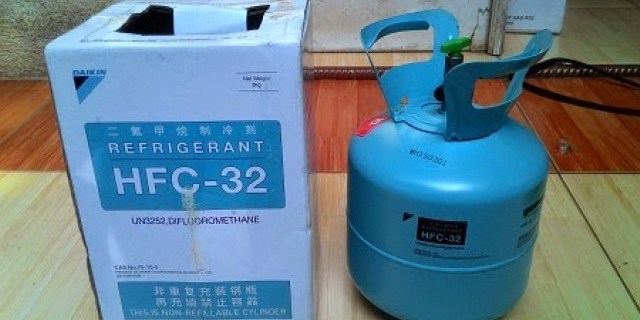
Among the refrigerants, hydrofluorocarbon or HFC is best suited for air conditioners. HFC is a family name for its members. Some of the HFC members are familiar names such as R132a, R410A, and R32.
HFC is the most common type of refrigerant used in residential air conditioners, particularly R410A and the newer one, R32. Check out my post on why R32 is the best refrigerant for air conditioners.
Older air conditioners mostly used R22 refrigerants. R22 falls under the family name called chlorofluorocarbon or CFC. Most CFCs, including R22, are getting banned in most countries due to their ozone-depleting capability that contributes to global warming.
Eventually, R22 and other CFCs will be phased out and newer, more environmental-friendly refrigerants will be replacing them.
In the meantime, I would like to inform you that you can learn quicker by getting my HVAC Begin (eBook) if you’re a beginner. But, if you have a year or two of experience, then I would suggest you consider my HVAC Basics (eBook). Nonetheless, I encourage you enroll in my HVAC Beginner Course: 10 Days to Become Competent in HVAC if you want to equipped yourself with a complete set of basic HVAC skills.
HVAC Beginner Course
Learn the most basics and foundational HVAC skills including cooling capacity calculation, equipment selection, duct sizing, pipe sizing, exhaust fan sizing, controls, electrical and more.
Why Refrigerant is Used in Air Conditioning Systems?
Refrigerant is used in an air conditioning system to transfer heat energy. A refrigerant absorbs heat from a room and rejects it outside the house. Thus, cooling the room.
R22, R410A, and R32 are the common refrigerant used in residential air conditioners because of their unique chemical properties. Below are some of the desirable characteristic of a refrigerant:
- Low boiling and freezing point
- Chemical stability
- Non-flammable
- Low toxicity
- Low cost
- Environmental-friendly
To explain why a specific refrigerant must be used, let’s assume if water is used as the refrigerant in an air conditioner. Water will not turn into vapor when it absorbed the heat from a room because of its high boiling point (relatively high when compared to R410A).
Subsequently, the liquid water enters into the compressor and the system fails because liquid cannot be compressed. Therefore, water can’t be used as the refrigerant in an air conditioner.
On the other hand, if R410A is used as the refrigerant in an air conditioner, R410A will turn into gas form when it absorbed the heat from a room due to its low boiling point (about 5°C at 120 psi). Thus, the refrigerant gas can be compressed and the system works.
PT Chart of Refrigerant
A PT or pressure-temperature chart is an essential tool in a form of a table or chart, representing the relationship of pressure and temperature of a refrigerant to design and troubleshoot air conditioning systems.
I’ll use R410A as the refrigerant to explain the PT chart and the operating pressure of an air conditioner.
A typical R410A split air conditioner operates at a pressure of about 120 psi at the suction line and about 430 psi at the discharge line. The operating pressure varies depending on the weather and heat load inside a room.
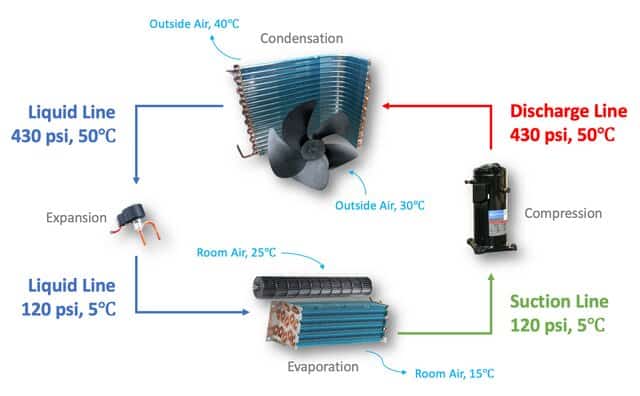
The pipe running from the condenser (outdoor unit) to the evaporator (indoor unit) is often called the liquid pipe because the refrigerant is in liquid form when traveling inside the pipe. The pipe running from the evaporator (indoor unit) back to the condenser (outdoor unit) is often called the gas pipe.
When discussing the refrigerant pressure, the gas pipe often breakdown into the suction line and discharge line, referencing from the compressor sucking and discharging the refrigerant.
A refrigerant has a fixed temperature at a given pressure. Increasing the pressure of a refrigerant will result in changes in its temperature. The relationship of pressure and temperature for R410A is shown in the below PT chart.
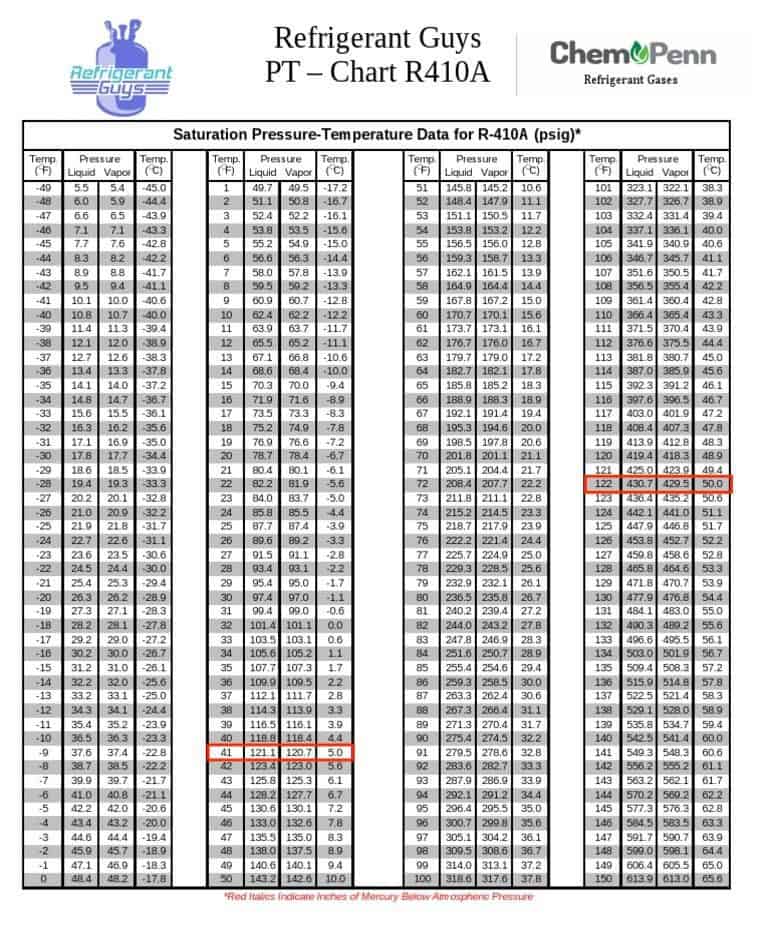
Using the PT chart, we can determine if the pressure of the refrigerant in an air conditioner is within the appropriate range or not. Incorrect pressure will cause problems such as not enough cooling and coil freezing.
Thermodynamics of Air Conditioning
Air conditioning process obeys the first law and the second law of thermodynamics. For simplicity, you can view the first law and second law of thermodynamics as the law of conservation of energy and thermal equilibrium respectively.
The law of conversation of energy states that energy cannot be created or destroyed, it can only be transferred. An air conditioner transfers heat energy from a room to the outside of a house, thus cooling the room. It does not create any “cold energy” to cool the room.
Thermal equilibrium is an instance where there is no net flow of thermal energy between two connected physical systems.
According to the second law of thermodynamics, two connected physical systems always arrive at a state of thermal equilibrium where the thermal energy always flows from the higher entropy system to the lower entropy system (can view as the thermal energy always flow from the hotter one to the colder one).
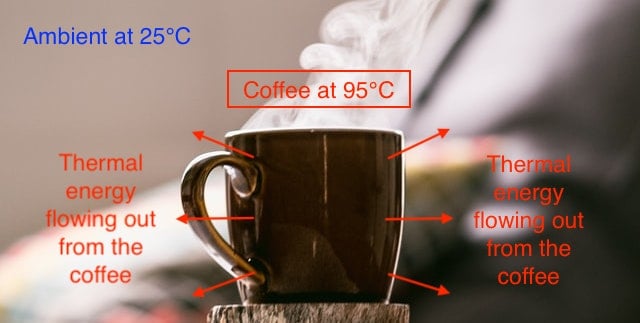
From the above illustration, the coffee will always become colder. The coffee will never absorb the heat from the ambient and become hotter because it will violate the second law of thermodynamics.
Cold refrigerant arrives at the indoor unit of an air conditioner. The heat energy from a room always absorbed by the cold refrigerant and carry away from the room. Thus, cooling the room.
Refrigeration Cycle Explained with Diagram
An air conditioner operates using the refrigeration cycle. There are many types of refrigeration cycles. The air conditioner is using the vapor-compression refrigeration cycle.
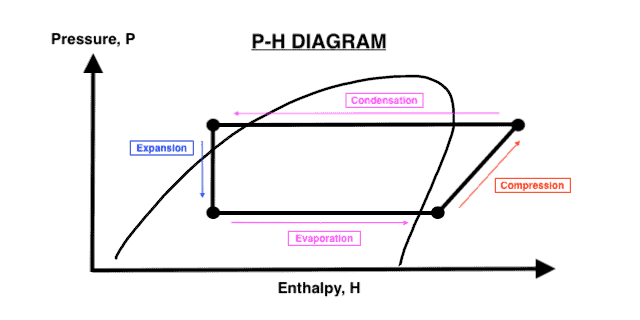
The refrigeration cycle of an air conditioner can be illustrated by a P-H diagram. The y-axis represents the pressure and the x-axis represents the enthalpy. For enthalpy, you can think of it as energy.
4 Cycles of Refrigeration
Whenever an air conditioner is turned on, the refrigerant goes through these 4 stages: compression, condensation, expansion, and evaporation. The cycle keeps on until the air conditioner is turned off.
1. Compression
In this stage, external power is injected into the system to compress the refrigerant. The refrigerant must be in gas form in order to make the compression possible.
- Pressure – increase
- Temperature – increase
- State – gas
During compression, the pressure and the temperature of the refrigerant gas increase, in preparation for the next stage.
2. Condensation
Condensation is a process where gas turns into liquid. Similarly, the compressed refrigerant, which is in gas form, turns into liquid form during this stage.
- Pressure – no change
- Temperature – no change
- State – from gas to liquid
During condensation, heat is extracted from the refrigerant gas, the enthalpy or the energy of the refrigerant gas drops, no change in pressure. Also, no change in the temperature of the refrigerant because the energy is used to convert gas into a liquid.
3. Expansion
When the refrigerant reaches this stage, it is in liquid form. Although the pressure is reduced during condensation, it is still relatively high.
- Pressure – decrease
- Temperature – decrease
- State – liquid & gas
During this stage, the liquid refrigerant expands rapidly causing a huge drop in pressure and temperature. After the expansion, the temperature of the refrigerant is about 5°C, ready to cool the room.
4. Evaporation
Evaporation is a process where the liquid turns back into gas. Now, the expanded liquid refrigerant begins the evaporation process by absorbing the heat from the room.
- Pressure – no change
- Temperature – no change
- State – from liquid to gas
While absorbing the heat from the room, the liquid refrigerant gains energy and started to boil. Remember earlier I mentioned that the refrigerant has to have a low boiling point?
After the evaporation stage, all liquid refrigerant should turn into gas form, goes back to the compression stage, and the cycle continues.
To learn more about HVAC, purchase and download the HVAC Begin (eBook).
8 Components of Air Conditioner
In this section, I’ll introduce the 4 major components inside an air conditioner that perform the 4 processes mentioned earlier.
1. Compressor
The compression process is performed by the compressor of an air conditioner. The compressor is located at the outdoor unit of an air conditioner.
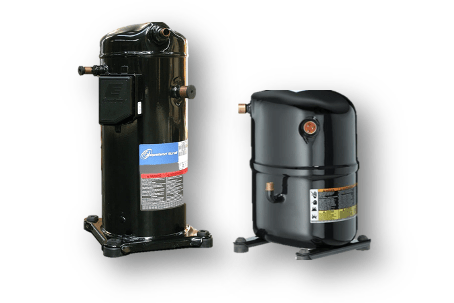
The compressor of an air conditioner is like the heart of a human. It is the main engine that drives an air conditioner. Its compression power is what pushes the refrigerant to circulate between the indoor unit and the outdoor unit of an air conditioner.
Compressor consumes the most power among the components of an air conditioner and it is the single most expensive component to replace.
There are many types of compressors such as scroll, reciprocating, screw, and centrifugal. Most of the residential air conditioners such as the split unit are using a scroll compressor.
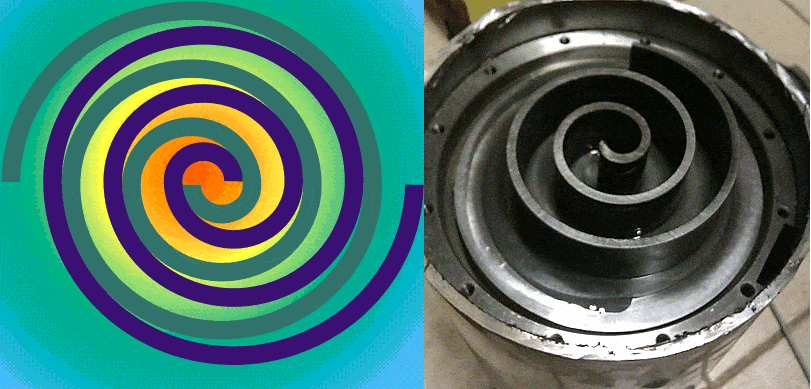
A scroll compressor spins to perform the compression. Refrigerant gas enters the compressor at the outer ring and then, is forced to travel to the inner ring, squeezed and compressed in the process.
Compressor contributes the most noise and vibration in an air conditioner. Thus, compressor rubbers are needed to reduce the vibration. The rubbers are placed at the leg of a compressor.
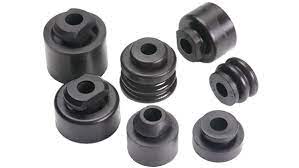
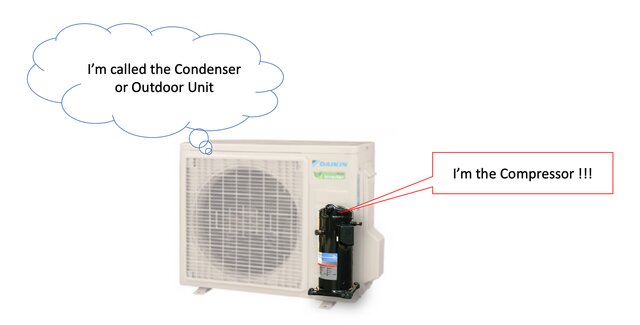
2. Condenser and Evaporator Coil
Condenser and evaporator coils are responsible for the condensation and evaporation process. The condenser coil is located at the outdoor unit while the evaporator coil is located at the indoor unit of an air conditioner.

The coils are where the heat transfer process happens in an air conditioner. In engineering terms, these coils are called heat exchangers. To be precise, they are called finned-tube heat exchangers.
A finned-tube heat exchanger is made of copper tubes and aluminum fins. Copper tubes are for the refrigerant to flow through while aluminum fins enhance the heat transfer process.
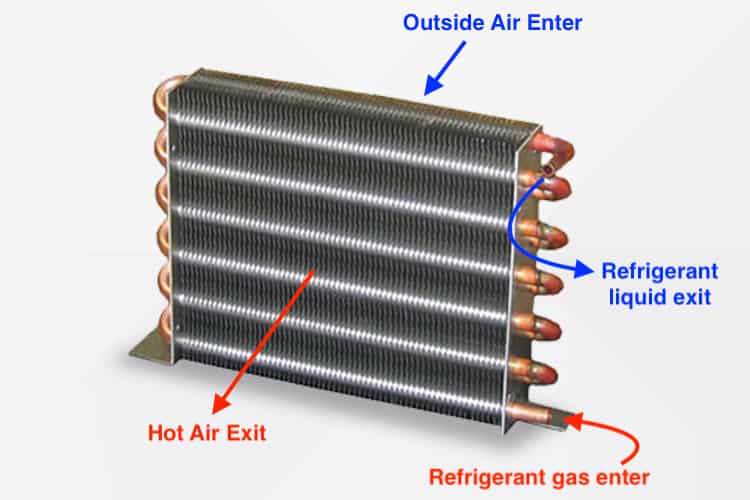
The material used for a heat exchanger is copper and aluminum because high-efficiency heat transfer is required. In another word, copper and aluminum are very good at conducting heat. This gives an air conditioner high energy efficiency and consumes lesser electricity.
Aluminum is silver in color in nature. Some air conditioners are equipped with blue color fins is because an anti-corrosion coating is applied to the aluminum fins to increase their durability.
3. Fan
Fans are used in air conditioners to circulate air through the condenser and evaporator coil. There are two sets of fans in a split air conditioner, one at the indoor unit and one at the outdoor unit.
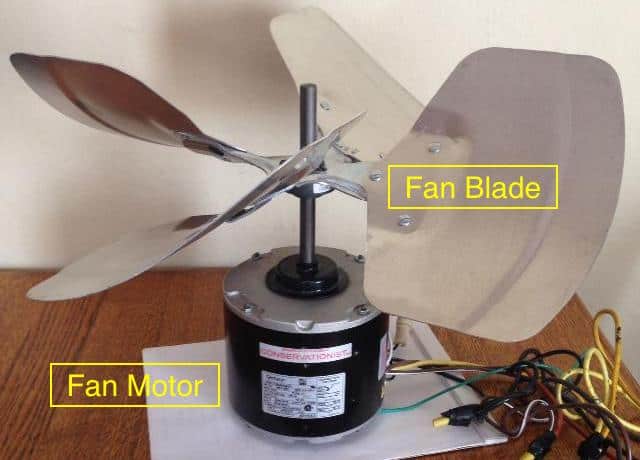
The fans are designed to provide a certain airflow rate. For instance, a 1HP (horsepower) air conditioner will always have an airflow rate of about 350 cfm (cubic feet per minute).
A fan can break down into two parts: fan motor and fan blade. Fan motor consumes electricity and performs the spinning motion. The fan blade is usually made of plastic that is designed at a certain angle of attack so that it can push air effectively. When attached together, they blow air.

Too much airflow causes incomplete condensation and evaporation, affecting the performance and lifespan of the air conditioner. Excessive airflow at the evaporator coil slows down the dehumidification process, resulting in the relative humidity of air not reduced to a comfortable level.


Fan blades are usually made of plastic due to their low cost and lightweight. The lesser it weight, the lesser energy it consumes. However, some applications required stainless steel which is a much more heavy material in order to resist corrosion.
The fan of an air conditioner consumes relatively less power, second to the compressor. Misaligned fans can produce excessive vibration and noise.
4. Expansion Valve
Expansion valve is a metering device that used to control the amount of refrigerant released to the evaporator while expanding it in the process causing a rapid drop in the pressure and temperature of the refrigerant.
An expansion valve can be found at the evaporator or the indoor unit of an air conditioner.

Commonly, there are two types of expansion valves: thermal expansion valves and electronic expansion valves. The thermal expansion valve is also known as TXV while the electronic expansion valve can be called EXV or EEV.
A thermal expansion valve contains a small amount of expandable gas in its sensing bulb. When a certain temperature is reached, the gas expanded and triggers an opening of the valve, allowing a certain amount of refrigerant to pass through.
An electronic expansion valve relies on an electrical signal to control its valve opening.
Unlike a thermal expansion valve which has a fixed range of operation, an electronic expansion valve is more flexible on the range of operation because the strength of its electrical signals can be altered by reprogramming the controller.
See below for detailed video on how the thermal expansion valve works.
Modern air conditioners use electronic expansion valves to achieve a more precise refrigerant control. Over time, the electronic expansion valve can save more energy than the thermal expansion valve.
5. Filter Drier
Filter drier is a filtration device used to capture small dirt particles and remove excess moisture in a refrigeration system. Filter drier can be found inside the outdoor unit of an air conditioner.

Particles such as metal chips and specks of dirt can be gathered inside refrigerant copper pipes during installation. When an air conditioner is turned on for the first time, these particles will be captured by the filter drier.
Besides, a filter drier removes excessive moisture in the refrigerant for the air conditioner to maintain its intended performance.
Because the refrigerant is circulating in a closed-loop, a filter drier only works whenever there is charging of refrigerant. In another word, excluding the initial startup, a filter drier is in action whenever there is a repair of refrigerant gas leakage.
The filter media inside a filter drier can’t be replaced, one whole piece of the filter drier has to be changed. Hence, some technicians might recommend changing the filter drier when repairing a refrigerant gas leakage.
6. Printed Circuit Board
Printed circuit board or PCB or IC board or control board, is an electronic board in an air conditioner used to control the operation of almost all of the components including the compressor, fans, expansion valve, and others such as remote control and inverter.

The PCB can be found in both the indoor unit and the outdoor unit of a split air conditioner. The indoor unit PCB allows the air conditioner to be remotely turned on/off, set temperature, fan speed, and timer.
The outdoor unit PCB provides on/off or inverter control to the compressor, regulates the condenser fan speed, and triggers safety devices in case of an emergency.
Modern air conditioners use PCB or electronic board extensively to provide better features such as mobile phone control via an app over the WiFi. If you’re new to PCBs, check out this article that compares PCBs to computer motherboards.
7. Accumulator Tank
Typically, you’ll see three black tank-alike components inside an AC outdoor unit. They are different in sizes; small, big, bigger. They are the filter drier, compressor, and accumulator tank.
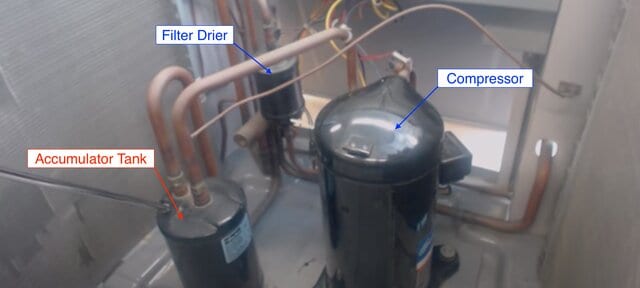
Accumulator tank is a protective device that prevents the liquid refrigerant from entering into a compressor, preventing the cause of irreversible damages to a compressor.
An accumulator tank is structured in a way that the gas refrigerant is prioritized over the liquid refrigerant when leaving the accumulator tank. Thus, protecting the compressor because liquid refrigerant is unable to be compressed.

I captured some of the images from AC Service Tech. Feel free to follow the link to an explanation video where they go in-depth on the accumulator tank.
8. Air Filter
Filter is used in an air conditioner to block dust and thus, simplify the cleaning process, maintain efficiency and prolong the lifespan of an air conditioner.
Fundamentally, a filter is not required for the operation of an air conditioner.
However, without a filter, dust will quickly gather at the condenser and evaporator coil, blocking air from passing through the coils, causing incomplete condensation and evaporation, affecting the performance and reducing the lifespan of an air conditioner.
With a filter, the majority of the dust can be captured before entering the coils. Once the filter gathered a significant amount of dust, it can be washed and reuse. A filter is an extremely convenient and cost-effective solution to maintain the performance of an air conditioner.
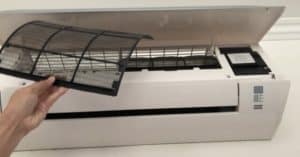

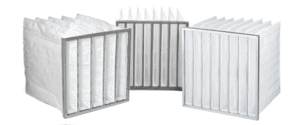

However, not all filters are washable. Usually, high-efficiency filters such as bag and HEPA filters, are not washable. They need to be replaced periodically to maintain their filtrating performance. These high-efficiency filters can be found in air conditioners in hospitals and clean rooms for semi-conductor.
Copper Pipe and Insulation for Air Conditioner
Copper pipes are used to connect the indoor unit and the outdoor unit of an air conditioner. Refrigerant circulates between the indoor and outdoor unit to remove heat from a room via the copper pipes.

The refrigerant inside the copper pipe is very low in temperature when traveling from the condenser to the evaporator.
Thus, insulating the copper pipes is necessary to prevent the losses of energy (or the losses of the coldness) and hence, to prevent the drop of energy-efficiency of the air conditioner.
Besides, insulating the copper pipe prevents water droplets from forming around the copper pipes due to condensation. Therefore, preventing water dripping.
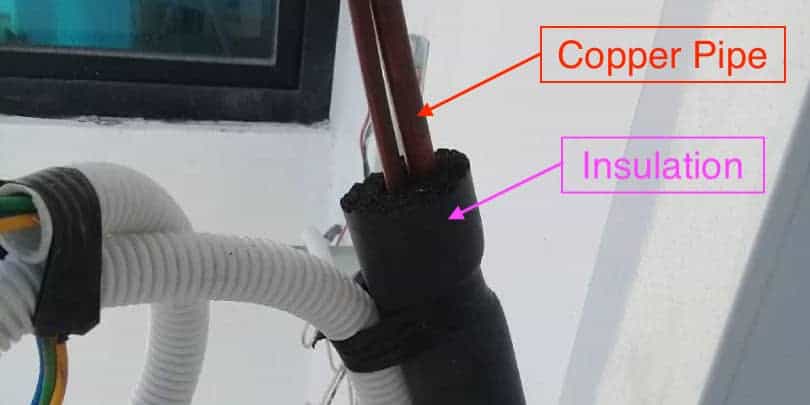
Copper pipe is always used to connect the indoor and outdoor unit of an air conditioner. No other materials are more suitable than copper. I wrote an article specifically on why copper pipes are used in air conditioning. The article covered the strength of copper in air conditioning and outlined why other materials are not suitable.
Dehumidification in Air Conditioning
An air conditioner not just cools the air but it also dehumidify or remove the moisture of the air.
Humans typically feel comfortable at temperatures around 22 °C to 27 °C and relative humidity at around 40% to 60%. Hence, an air conditioner must remove some of the moisture in the air to provide maximum comfort.
An air conditioner removes moisture through the condensation of water vapor in the air.
Not to confuse with the condensation of refrigerant, the condensation of air occurs at the evaporator or indoor unit of the air conditioner. During condensation, moisture in the air will form water droplets and discharged via the drain pipe of an air conditioner.
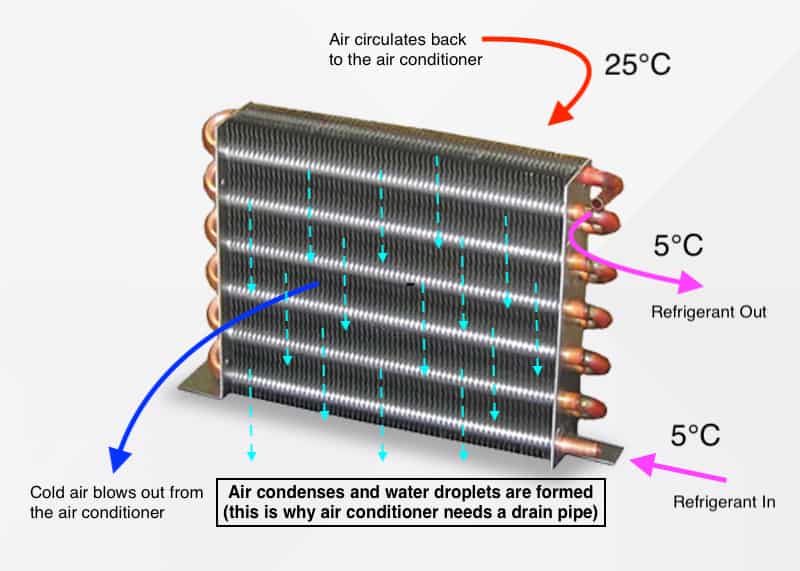
In order for the water vapor in the air to condensate, the temperature of the contacting surface must be below the dew point of the air at the given moment.
Air circulates back to the indoor unit of the air conditioner and passes through the chilling evaporator coil. Because the cold refrigerant is passing through the evaporator coil, the evaporator coil can be at a temperature below 10°C.
In Malaysia, the average dew point of air is 24°C. The temperature of the contacting surface (evaporator coil) is well below the dew point. Therefore, water vapor in the air condenses into liquid water and the relative humidity of the air drops, the air is dehumidified.
If you wish to know more, here are some of my other posts related to dehumidification:
Air Conditioner Wiring
Typically, a single-phase power cable connects to the outdoor unit of a residential split air conditioner. From the outdoor unit, one set of single-phase power cables is connected to its indoor unit. For inverter type, one extra signal cable is required for the indoor unit.
Most residential air conditioners are with a capacity of not more than 2.5HP. The rated current of a 2.5HP air conditioner is about 8A to 9A depending on brand and model. Thus, 3x1c 2.5mm2 PVC cable is sufficient. As for signal cable, it is usually 1x1c 1.5mm2 PVC cable.
Relevant post: Air Conditioner Wire Sizing Guide: Chart & Calculation.
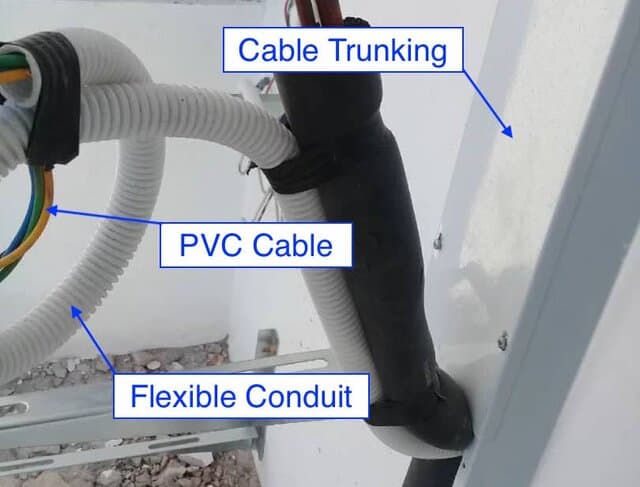
Cables must be protected with conduit to prevent the cable “skin” or cable jacket from damages and causing cable short circuit and more serious issues such as electrocute.
Conclusion

First of all, at its core, an air conditioner is working based on the laws of thermodynamics. An air conditioner uses the refrigeration cycle to perform heat absorption and rejection and therefore, provide cooling.
Next, air conditioners require specific refrigerants to operate. The refrigerant in an air conditioner goes through 4 processes which are compression, condensation, expansion, and evaporation.
Then, there are 4 major components in an air conditioner: compressor, condenser & evaporator coil, fan and expansion valve are responsible for the 4 processes in the refrigeration cycle. Other components in the air conditioner are minor but important to the overall performance of the air conditioner.
Besides, copper is always used as the refrigerant pipe to connect the condenser (outdoor unit) and the evaporator (indoor unit), and aluminum are often used as the fin of the condenser & evaporator coil because both of them are very good heat conductor.
Moreover, an air conditioner not just cools the air but also dehumidifies the air to a level that is comfortable for humans. Water vapor condensates into liquid water and discharged through the drain pipe of an air conditioner, reducing the relative humidity of the air.
Lastly, air conditioners require power and thus, properly sized cables must connect the condenser (outdoor unit) and evaporator (indoor unit) with appropriate conduit for cable protection.
Lastly, consider my HVAC Begin (eBook) if you’re a beginner and you want to have a foundational knowledge in HVAC. But, if you have a year or two of experience, then I would suggest you consider my HVAC Basics (eBook). Nonetheless, I encourage you enroll in my HVAC Beginner Course: 10 Days to Become Competent in HVAC if you want to equipped yourself with a complete set of basic HVAC skills.
HVAC Beginner Course
Learn the most basics and foundational HVAC skills including cooling capacity calculation, equipment selection, duct sizing, pipe sizing, exhaust fan sizing, controls, electrical and more.
If you have anything to add (or ask) about this topic, leave a comment down below!


